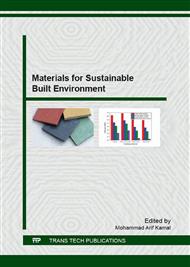p.54
p.66
p.74
p.82
p.94
p.104
p.110
p.119
p.129
Modelling of Formwork Pressure Using Self-Compacting Concrete by Numerical Methods for Attaining Environmental Sustainability
Abstract:
Self-Compacting Concrete does not require any kind of external vibration for its placing and compaction. It possesses the ability to flow under its own weight and to fill the formwork completely which will result in full compaction even in the case of congested reinforcement. The pore structure of the self-compacting concrete is different that of traditional concrete which results in changes in durability behavior. The pressure exerted by the concrete mix has its own significance in defining the durability aspects of the self-compacting concrete. This research includes a brief review how efficient modelling of SCC can be used to achieve sustainability. The prevision of the theoretical model are compared with the pressure value obtained at the end of casting carried out on a formwork along with the readings of the progression of probable yield stress of the cast concrete. After this the assumptions of the model during casting phase are compared to the results from the available literature and explain the validity of the proposed model to explain and forecast the experimental review.
Info:
Periodical:
Pages:
119-128
Citation:
Online since:
May 2016
Authors:
Price:
Сopyright:
© 2016 Trans Tech Publications Ltd. All Rights Reserved
Share:
Citation:


